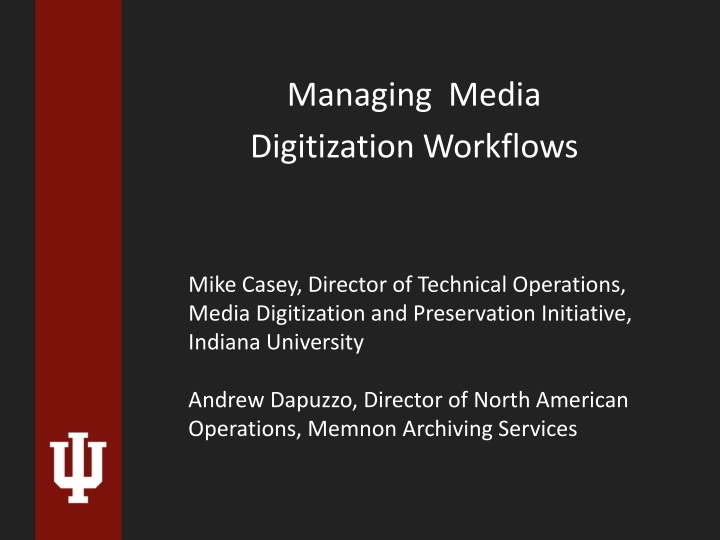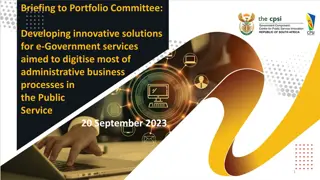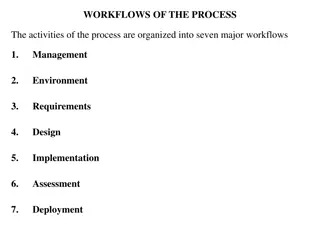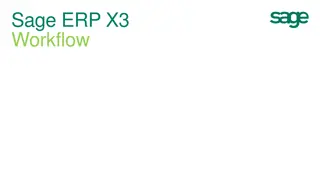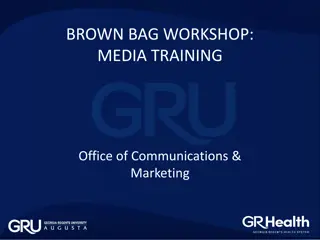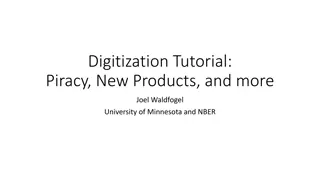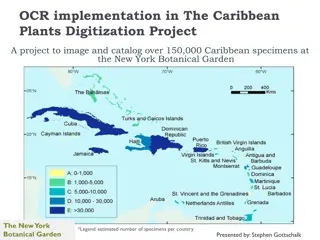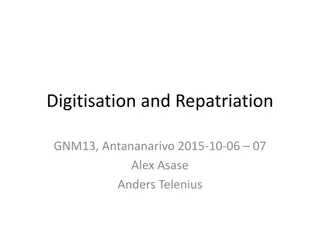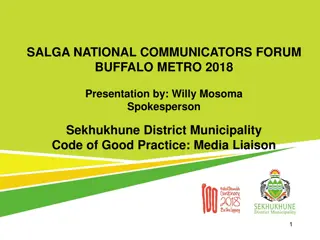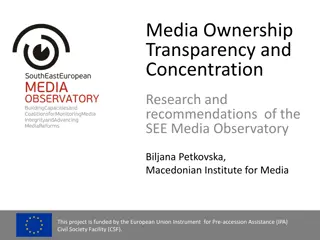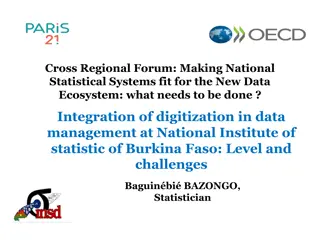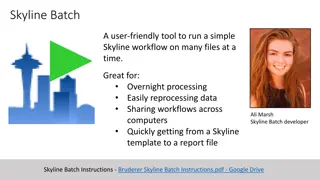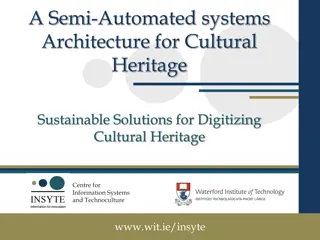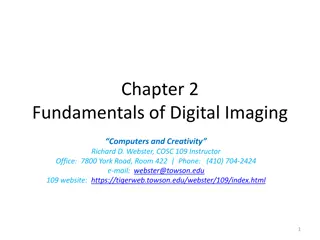Managing Media Digitization Workflows - Overview and Strategies
This content delves into the managing media digitization workflows led by Mike Casey, Director of Technical Operations at Indiana University, and Andrew Dapuzzo, Director of North American Operations at Memnon Archiving Services. It covers the Indiana University Media Digitization and Preservation Initiative (MDPI), including its goals, strategies, and achievements. The information provides insights into the digitization processes for audio and video recordings, preservation techniques, productivity systems, and the application of General Systems Theory in media preservation system design.
Download Presentation

Please find below an Image/Link to download the presentation.
The content on the website is provided AS IS for your information and personal use only. It may not be sold, licensed, or shared on other websites without obtaining consent from the author.If you encounter any issues during the download, it is possible that the publisher has removed the file from their server.
You are allowed to download the files provided on this website for personal or commercial use, subject to the condition that they are used lawfully. All files are the property of their respective owners.
The content on the website is provided AS IS for your information and personal use only. It may not be sold, licensed, or shared on other websites without obtaining consent from the author.
E N D
Presentation Transcript
Managing Media Digitization Workflows Mike Casey, Director of Technical Operations, Media Digitization and Preservation Initiative, Indiana University Andrew Dapuzzo, Director of North American Operations, Memnon Archiving Services
Manage administer conduct govern guide handle maintain operate oversee regulate run supervise take care of train use advocate captain counsel designate direct disperse engineer execute head influence instruct minister officiate pilot ply preside request steer superintend watch care for carry-on engage in
Indiana University Media Digitization and Preservation Initiative (MDPI) Overview Digitally preserve all significant audio and video Complete by IU Bicentennial in 2020 University-wide initiative
MDPI Digitization Strategy Sony Memnon parallel transfer (industrial-scale) workflows IU 1:1 workflows for fragile formats and problem items Digitally preserve approximately 280,000 audio and video recordings Digitized 141,198 as of last Friday 6.5 PB in 4 years
IU Media Digitization Studios Audio preservation 7,000 field cylinders, lacquer discs, mixed speed tapes, wire recordings Sound Directions 1:1 workflow
IU Media Digitization Studios Video preservation Hi 8/8mm, Betamax, EIAJ Problem VHS, Umatic, Betacam SP
IU Media Digitization Studios Productivity Systems thinking Theory of Constraints principles Scrum methodology Scripts
General Systems Theory Theory created in the 1930s in which complex systems are viewed holistically Way of thinking Aid evaluation of media preservation system design, effectiveness, sustainability, completeness, and behavior
Theory of Constraints Overview Developed by Dr. Eliyahu Goldratt in the early 1980s Methodology for identifying the most important limiting factor that stands in the way of achieving a goal Improve constraint until it is no longer a limiting factor
Theory of Constraints Overview define terms Constraint is a limitation or restriction Constraint = bottleneck Bottleneck = stage in a process where progress is impeded, weakest link in the chain Throughput is the quantity of raw material processed within a given time
Theory of Constraints Overview Every process (workflow) has a constraint Throughput is governed by how much can be run through the constraint per period of time Throughput improves when constraint improves Improving a non-bottleneck does not make the workflow more productive
Theory of Constraints Five focusing steps Identify find the bottleneck Exploit quick improvements using existing resources Subordinate everything else must support the above Elevate further actions to eliminate bottleneck may include capital investment Repeat continuous improvement cycle
Typical audiotape digitization workflow Manager assigns work Engineer Inspects tape Winds tape Checks and repairs splices Repairs pack problems Gathers technical metadata Engineer digitizes
Theory of Constraints Where is the bottleneck in our system? Workflow step with capacity equal to or less than the demand placed on it
Theory of Constraints Exploit and elevate Offload tasks from the bottleneck and place elsewhere Place QC before the bottleneck
New digitization workflow Manager assigns work AV Specialist Inspects tape Winds tape Checks and repairs splices Repairs pack problems Gathers technical metadata Engineer digitizes
New digitization workflow Manager assigns work Engineer digitizes AV Specialist Inspects tape Winds tape Checks and repairs splices Repairs pack problems Gathers technical metadata Engineer digitizes
Theory of Constraints Exploit and elevate Offload tasks from the bottleneck and place elsewhere AV Specialist Place QC before the bottleneck AV Specialist Create inventory buffer before bottleneck Keep the bottleneck working as much as possible If bottleneck is idle for an hour, lose the cost of an hour for entire system An hour saved at a non-bottleneck is a mirage
Management of Digitization Workflow How can we Support choice Foster investment and engagement Keep morale high Track which recordings should be digitized next
Management of Digitization Workflow Scrum methodology Part of the Agile software development movement Emphasizes collaboration, team self- management, and flexibility to adapt to emerging realities
Management of Digitization Workflow Scrum methodology characteristics Time is divided into short work cadences known as sprints Two week sprints Evaluate and plan next steps at end of sprint Daily meetings to assess progress (standups)
Management of Digitization Workflow Scrum methodology Enter backlog into Jira Divide recordings into groups based on technical characteristics Engineers select groups to commit to for sprint Story points = duration of group (minutes)
Management of Digitization Workflow Scrum methodology Built-in frequent feedback loops for both technical staff and administration Always know where things stand Supports philosophy of constant improvement Focus on two-week commitments not endless future Engineers have choice
New digitization workflow Manager assigns collection Engineer chooses recordings Engineer digitizes AV Specialist Inspects tape Winds tape Checks and repairs splices Repairs pack problems Gathers technical metadata Engineer digitizes
Managing Media Digitization Workflows Mike Casey, Director of Technical Operations, Media Digitization and Preservation Initiative, Indiana University Andrew Dapuzzo, Director of North American Operations, Memnon Archiving Services
